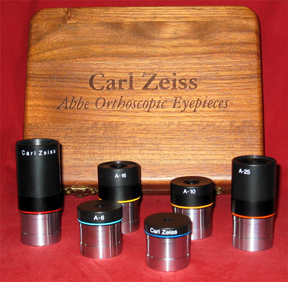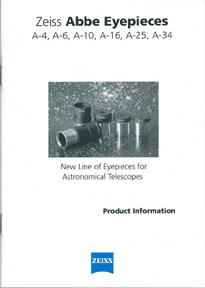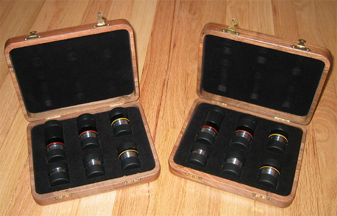(101点) Takahashi μ-300
(96点) ASTRO-PHYSICS 160EDF
(96点) Zeiss APQ150
(95点) Takahashi TOA-150
(95点) TMB 152mm/F8-CNC-LW
(95点) Takahashiμ-250
(93点) ASTRO-PHYSICS 155EDFS
(90点) INTES-MICRO ALTER A-608
(90点) ZEN250
(88点) CELESTRON C-11
(88点) Takahashi FS-152
(88点)INTES-MICRO ALTER-7N
(86点)AOK K150/3000 Zerodur
(86点)Orion 250cmF6.3
(85点)Takahashi TOA-130F
(84点)TMB 130mm/F9.25-LW
(84点)Zeiss APQ130
(84点) TEC-140
(84点)Takahashi TOA-130NST
(83点) AP SFX130EDT 130mmF7.8
(83点) AP 140EDF4 140mmF7.5
(83点) ASTOROSIB 250RC
(82点) Zeiss MENISCAS180
(80点) Vixen VMC260L
(78点)TEC MAK200F11
(77点)Takahashiμ-210
(76点)TMB 130mm/F6(暫定点数)
(76点) AP 130EDFGT 130mmF6.3
(75点)TeleVue NP127
(75点)INTES-MICRO ALTER-607
(75点)INTES MN-61
(74点)Takahashiμ-180
(73点)Takahashi TSA-120
(73点)Takahashi FS-128
(73点)INTES-MICRO ALTER-7
(72点)William Optics FLT132
(72点)Takahashi CN212
(70点) TMB 115mm/F7 LW
(70点)PENTAX 125SDP
(70点)Takahashi FS-102 TWIN+EMS
(70点)CELESTRON C8
(70点)Kasai NERIUS-127EDT
(69点)BORG150ED
(69点)Orion OMC-140
(69点)Zeiss APQ100/1000
(68点)William Optics10cmF8
(67点) TeleVue NP101
(67点)Takahashi TSA-102
(66点)Zeiss APQ100/640
(66点)TAKAHASH FSQ-106ED
(66点)NIKON 10cmED
(66点)William Optics FLT110
(65点) Vixen FL102
(65点)Takahashi FSQ-106
(64点) TeleVue TV101
(63点) TeleVue TV102
(63点)Takahashi FS-102
(63点)PENTAX 105SD
Friday, December 01, 2017
Wednesday, November 15, 2017
ASTRO-PHYSICS SUPER PLANETARY SERIES EYEPIECES
http://www.company7.com/astrophy/options/apsuperplan.html
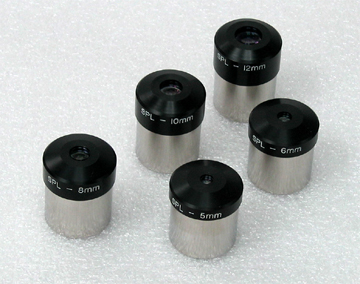 Introduced Summer 2004 in limited quantity - like all other AP products. This article expanded after the arrival of our first 4mm in 2005.Overview: a telescope is the light bucket that gathers light and forms one virtual image, the eyepiece (or ocular) enlarges that image and focuses it to a point where it can be seen by the eye. It used to be common wisdom that a refracting telescope could be usefully operated at magnifications as high as something on the order of between twenty five to fifty magnifications per inch of aperture (1 to 1-1/2 per mm); and so a four inch aperture telescope (about 100mm aperture) could operate at between 100 to 200x. However, with dramatic improvements in refractive lens technology attained over the recent decades this limit is now on the order of better than three times the aperture - or about 300X or more for a very well made four inch apochromat. Just as the objective lens technology has advanced, so has that of the eyepieces that go onto a telescope. A number of names can come to mind whom we can credit for the advances in eyepiece design over recent years - and now that list includes Roland Christen. Right: Astro-Physics Super Planetary Eyepieces showing (left to right): 8mm, 10mm, 5mm, 12mm, and 6mm. The SPL 4mm eyepiece was not available to be included at the time this article was written (80,303 bytes) Click on image for higher quality, enlarged view (172,912 bytes). The Astro-Physics "Super Planetary" (or SPL) is an original three element eyepiece design by Roland Christen, the founder and lens designer of the world renowned Astro-Physics Company near Rockford, Illinois. Mr. Christen has attained an uncommonly good understanding of optical theory and practice, with experience he has gleaned from decades of of designing, manufacturing and testing many of the best refractive telescope optics in the world. Previously, Astro-Physics customers selected a telescope and then bought their eyepieces from third parties. By 1994 Astro-Physics and Company Seven became the only American source of a then new high resolution eyepiece benchmark: the Carl Zeiss Abbe Orthoscopic. The term "orthoscopic" denotes an eyepiece that introduces no barrel or pincushion distortion, so that an object will have the same size when observed anywhere in the field of view. The Abbe design employs a triplet field lens and a singlet eyelens. The Abbe Orthoscopic eyepiece were optimized for use on the planets and in their shorter focal lengths of from 4mm to 10mm are not recommended for use when wearing spectacles. Any new product from Astro-Physics is greeted by much enthusiasm and speculation. Accordingly true to form, Mr. Christen has provided the astronomy community with another fine choice of product. However, this time it is his first foray into production eyepieces. The three element "Super Planetary" series eyepieces were first publicly hinted at in late 2003. The first examples of the SPL in 5mm focal length were shipped in December 2003. While the first several nearly complete sets were delivered in Spring and Summer of 2004 the introduction of the 4mm SPL was delayed at the time this article was first written; when the 4mm came available we added information about it to this article. The original factory plan was that these eyepieces would become available in some numbers by the Fall of 2004, and in stock by 2005. As it turns out the ramp up process and sporadic production have rendered the availability poor, we have been so confused about what is available and when that we have generally not been accepting new orders for these eyepieces - even while some other retailers have promised delivery dates that are incongruous. However, these are all on display at Company Seven's showroom. The SPL's will not replace all other choices for use on Astro-Physics telescopes since they were developed only to meet the requirements of a small percentage of the observing population. And so most of our community will continue to rely on other highly perfected complimentary designs most noteworthy which are the innovative Nagler, Panoptic and Radian series devised by Al Naglerthe founder of TeleVue Optics for example. Regardless, the preliminary and sensible comments made by Roland Christen never seem to keep people's imaginations from running away. Design Imperatives: this series were developed with a few basic goals in mind:
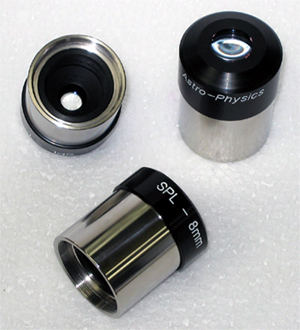 SHARED CHARACTERISTICS OF THE SPL
Click on image for high quality, enlarged view (200,490 bytes). The eyepieces have these air to glass surfaces: front and rear of first group of two cemented lenses, front and rear of eye lens. Filters: Since high resolution eyepieces are so often used on relatively bright objects (planets, moon, etc.) the Super Planetary eyepiece barrels are threaded to accept standard thread on 1.25 inch (M28.5 x 0.6) filters including Color, Neutral Density and Sky Light Pollution Reduction. EYEPIECE PRICE AND PLANNED AVAILABILITYThe Astro-Physics Super Planetary series were initially going to be distributed only directly from Astro-Physics. It was anticipated that once production came up to speed then the full line Astro-Physics retailers Baader Planetarium in Germany and Company Seven in the USA and possibly some other retailers would be allowed to offer these but this has since changed. These are good eyepieces however, the availability of these has eyepieces to Company Seven has been so problematic that we can not accept orders for these eyepiece for the foreseeable future. Regardless, a complete set of these will all remain on display at Company Seven's showroom.
OUR IMPRESSIONSWe at Company Seven tire of what we refer to as the "eyepiece du jour" syndrome. This is when someone obtains the first of a new eyepiece (usually one that few others who are credible have evaluated) and then they rave to all that it is the best in the world - they remind us of an old elementary school acquaintance who used to boast "I have one and it's the best, and you don't". First of all they are probably wrong, and secondly there are too many design properties of an eyepiece to factor before can set forth such a blanket statement. Many of us are willing to give up some fractional amount of fine detail provided by one design of eyepiece for the increased comfort or field of view of another design. And there is a good reason why some eyepieces have six, seven or more elements - and it has nothing to do with bragging rights; each element is there for some reason. Until aspheric designs become practical to produce, we are likely to see several elements in the better wide angle designs, and a few in narrower field of view designs. Some of us seek out the finest telescopes regardless of cost, and the eyepiece that will show the most clear and clean image regardless of all other considerations. So just as they make chocolate for some and vanilla for others, there is not one clear best choice of eyepiece for everybody - the technology is not yet at that point.We compared the SPL against a number of the better regarded production eyepieces. And there was also some comparison of the SPL's against similar focal length eyepieces out of production from our collection. Visual evaluations on very fine resolution targets were performed in daylight outdoors, and indoors. Indoors testing was also done with an artificial star, under reflected powerful and distant (to reduce heat effects) quartz halogen, and also with artificial daylight sources in a controlled environment. The advantage indoors is that we know the distances, and can control the seeing conditions. The comparative evaluation out doors were performed looking at fine details on distant leaves under overcast seeing conditions; a Leica rangefinding binocular was used to check distance to the closer (< 1,300m) targets. The telescopes we employed were:
2. Astro-Physics 92mm "Stowaway" f/6.6 refractor, 3. an economical new f/9 refractor, the 100mm ED Apo, and 4. a TeleVue NP101 Apo refractor.
The ability to transmit a high percentage of light and focus it so precisely means that one will not only see better detail on bright targets, but that one is likely to see fainter stars in the field of view than that provided by less capable designs. 2. There were no ghost images or undesired reflections from the field end of the eyepiece, and so you will not know when your telescope is near a bright star until the star actually enters into the field of view of the SPL. In an illuminated room we noted some modest reflection of light within the SPL caused by off axis room lighting or a camera flash, but this was modest or less than that found in most other eyepieces. Generally speaking if you set the eyepieces on a black cloth in daylight the lenses will most likely appear transparent, similar to the Zeiss Abbe. An observer having to contend with stray lighting might find it helpful to wear a dense black cloth hood overhead (not white, especially in the Southern states) or use an eyecup. We prefer to use the design of eye guard such as those provided with the Orion Ultrascopic (Baader Eudiascopic) series which we will stock. 3. The glass used is very transparent, the coatings attenuate some wavelengths that would otherwise cause some reduction in perceived detail. This has to do with dealing with eye physiology and not simply pure light throughput. 4. The balance of design Field of View and Eye Relief provide a practical balance for the designed purposes. In these respects the SPL compare similarly to the other eyepieces which we considered to be the reference standard to date. We could comfortably observe with as short a Focal Length SPL as the 10 mm without making eyelash contact. Other eyepieces tested that were designed with better eye relief than the SPL's showed lower contrast to one degree or another. 5. We do not generally recommended the SPL eyepieces (or most other simple designs) in focal lengths of from 4mm to 10mm for use by spectacle wearers since the distance from the eye lens to the exit pupil is too short to permit seeing the entire field of view. However, some observers with astigmatism may find that when observing at such high magnifications then the exit pupil is so small in diameter that it may bypass the off center area of the Cornea that is introducing astigmatism. And so some spectacle wearers may find the SPL's useable. Alternatively, it is a simple matter when observing a small object such as planet to back the eye away from the eyepiece. This will result in a narrowing the apparent field of view, in the case of the shorter focal length SPL's we found this to be around 30 degrees or somewhat less. This change of observing position can make several SPL's come within reach of many spectacle wearers. 6. These are not "wide angle" or long eye relief eyepieces, and considering their high magnification and comparably narrow field of view these would not be our first choice for applications involving: 8. Company Seven evaluated our first production SPL eyepieces for cleanliness and they present a very clear image free of internal lens contaminants. However, some field stops showed artifacts that would not be visible at night unless scanning across a well illuminated target such as the Moon, or on the Sun; we could remove these easily enough. 9. The classical Carl Zeiss Othoscopic design eyepiece of Ernst Abbe was designed for use with telescopes of f/10 or greater. The Zeiss Ortho design that was most recently in production were the Abbe Orthoscopic design, and these were optimized for telescopes of f/8. It is quite an accomplishment that the SPL series work well for their intended purposes at ratios as fast as f/4. 10. Color fidelity appeared excellent using a daylight source on targets across the visual spectrum. The SPL design correction peaks in the yellow green region of the visual spectrum as does the human eye. But even with the choice of coating employed, these remain useful beyond the visual and were measured with a sensor to transmit below 400nm in the UV, and above that notably into the IR. 11. When an observed target is off center in the field of view the SPL then the performance remains consistently good. And so these can be quite suitable for close in observing of star clusters which provide pinpoint stars across the field of view. 12. At the high magnifications these SPL's can provide, any speck of dust on the lenses of any similar focal length eyepiece will appear obvious and egregious. So it is important to keep these clean. 13. Considering SPL field of view and eye relief as compared against other first rate high resolution designs shows: 14. An optional good quality negative lens (Barlow) can provide higher magnifications for those who demand an increase in magnification, or increase in the number of available magnification fine "steps", or a bit longer eye relief. The SPL is useable with all Barlow lenses, especially when using the SPL eyepiece on targets at night or when they are in the center of the field of view. However, the best performance across the entire field of view is attained when using a TeleVue Powermate lens; this is a negative lens incorporating a beam shaping component.The least desirable visual results were obtained when using the comparatively simple and compact 1.25" Barlow lenses such as the Vixen Ultima (Orion "Shorty Plus") or the Barlow installed in the Questar 3-1/2" telescope. We also noted that even the better eyepieces (including the TeleVue Radian) performed better with more refined (and more costly) Barlow or TeleVue Powermate lenses. 15. The SPL is not very sensitive to eye placement. As long as you can line your eye up to the exit pupil then you will see the target even if your head is tilted a bit off axis or slightly off center. There is no black out effect when observing daytime or at night. 16. The ease of eye placement, and the apparent field of view which provides about the angular dimension across which the human eye can focus makes these a good choice for use with an optional Binocular Viewer, even more so if weight of the payload poses some concern. 17. The SPL eyepieces came were assembled from two production lots, these we evaluated are close but not parfocal. 18. The smooth Derlin housing is comfortable to handle even in extreme cold, and this is good since one will need to handle these with a firm grip to avoid having an SPL slip out of the hand. Some of us might find it better to have some ridge running the circumference of the Derlin. We all felt it is too easy to unscrew the stainless steel barrel from the upper assembly. These are included here as personal preference notes. 19. The engraved and painted writing on the SPL's are easy to read when they are held in low or red light. The focal length designation is only visible when the number is turned towards the observer. In practice, the owner may learn to judge focal length simply by noting the differences of height. However, it might be helpful to provide some kind of more obvious focal length coding (extra f.l. engraving, lines, etc.) around the SPL to more readily distinguish one focal length from another in the dark. 20. We did not test the SPL with an optional positive lens (telecompressor) in place. It seems pointless to buy high magnification eyepieces then place a lens into a telescope to reduce that magnification. 21. At such high powers, a telescope equipped with a smooth fine geared focuser (such as the Questar 3-1/2, Astro-Physics 92, etc.) can sure make the testing go a bit easier. 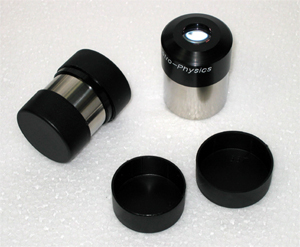 It makes little practical difference how the SPL series compare against obsolete, or out of production designs. The fact is these are about as good a performance, practical, high resolution "super planetary" eyepiece as one can obtain in 2004. Assuming their eye relief and field of view are compatible with observers needs, then these will be popular within the community of those who seek the highest possible detail: double star observers, occultation chasers, and planet watchers. And of course there will be some who just want to know they own a set for the bragging rights. Right: Astro-Physics Super Planetary Eyepieces with and without lens caps in place, and with set of covers to the side (51,932 bytes). Click on image to see a higher quality, enlarged view (137,698). SUPER PLANETARY EYEPIECE SPECIFICATIONSMeasured by Company Seven August 2004 and August 2005
* Specifications are subject to change without notice. CLEANING & MAINTENANCE INSTRUCTIONS
| |||||||||||||||||||||||||||||||||||||||||||||||||||||||||||||||
CARL ZEISS "ABBE ORTHOSCOPIC" EYEPIECES
http://www.company7.com/zeiss/products/czabbeoclr.html
CARL ZEISS "ABBE ORTHOSCOPIC" EYEPIECES
The new standard of excellence in high resolution eyepieces
7 April 1997
The new production Carl Zeiss Abbe Orthoscopic series oculars are now available in limited quantity, and only as a set of five with one optional ocular. These are: 4mm, 6mm, 10mm, 16mm, 25mm. An optional sixth ocular of 34mm is also available soon. It is planned that only 100 five piece sets will be made available in the United States. These will be sold only by Astro-Physics Co. and by Company Seven Astro-Optics Division of Laurel, Maryland. All are on display in Company Seven's showroom and at least a few sets will remain on display and stored in our museum collection.
Company Seven will contact its customers to advise them of the product availability. And it is planned by Company Seven to accept orders for these items only from those who have already established a customer relationship, and to members of the "Carl Zeiss Historica Society". Even then, the availability issue is such that we ask our clientele to buy only one set, or possibly as many as two sets if they have a binocular viewer.
Right: Carl Zeiss Abbe Orthoscopic series oculars with optional laser engraved solid walnut wood presentation case.
In front of case are (left to right): 34mm, 6mm, 16mm, 4mm, and 25mm. Models with extendable eyecup are shown with eyecup retracted (89,603 bytes).
Click on image for higher quality, enlarged view (321,968 bytes).
Design: The design of the original Orthoscopic eyepiece dates back to the 1800s when Ernst Abbe first designed them to be used for accurate measurements of linear distance on microscope slides. The term "orthoscopic" denotes an eyepiece that introduces no barrel or pincushion distortion, so that an object will have the same size when observed anywhere in the field of view. The Abbe design employs a triplet field lens and a singlet eyelens.
The modern Carl Zeiss Abbe Orthoscopic series that we now offer use a high index Schott Lanthanum glass to reduce the already low off-axis aberrations present In a good orthoscopic design. These oculars, when used with a high quality apochromatic telescope of f7 or longer focal ratio, will offer images of the planets which will appear clean and free of false color fringing from the center to the edge of the field of view.
The apparent field of view of each of these oculars is 45 degrees, the exception being the 34mm ocular which affords a 40 degree apparent field. In side by side comparisons, the fields of view actually appear to be equal to or slightly larger than Plossl oculars advertised as having 50 degree apparent field of view.
This Carl Zeiss Abbe Orthoscopic series oculars are parfocal. Each ocular is threaded for 1.25" diameter standard filters. The ocular barrels are of a dull black finish with a color coding band, with "Carl Zeiss" and the respective focal length ("A-16" for example) on each. The 1.25" barrel is chromed, and each features a machined safety groove to reduce the possibility of accidental loss from a focuser. The 16, 25 and 34mm focal length models incorporate a retractable (not fold down rubber) eyecup.
Each ocular is passed through very high quality control measures to assure perfection of raw materials, manufacture and assembly. Each is then furnished with a slip-on black plastic cover for the eye lens end of the ocular, with another cover for the 1.25" barrel. Each is packaged in a "zip lock" plastic bag with the Carl Zeiss Jena product description, numbers and final quality control inspection marks. In addition each set of five (4, 6, 10, 16, and 25mm ) is furnished in a walnut wood presentation case which is laser engraved with "Carl Zeiss Abbe Orthoscopic Oculars" and the current Carl Zeiss trademark. The walnut case will accommodate the optional 34mm ocular.
Coatings: Each of the 4 air to glass surfaces is multi-coated with the Zeiss patented "T" multilayer coatings; these are designed to achieve the highest possible light-transmission and contrast.
It is in this area where the Zeiss Abbe orthoscopic has no equal. The total measured light transmission (including the internal glass absorption losses) exceeds 97%. For high-power planet observers, this means that planets appear bright and sharply defined, with none of the grayish-white haze surrounding the ball of the planet as is common in many other oculars.
The visual impression is striking. It Is almost as if a thin veil has been lifted, thereby revealing the most subtle contrasting features more clearly. There is a similar effect for deep-sky observers using the longer focus, low-magnification Zeiss Abbe Orthoscopic series oculars. Even though the field width is not spectacular, the enhanced contrast on small bright and faint objects really can be worth it.
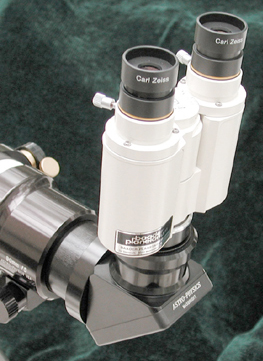
Recommended For: These eyepieces are designed primarily for solar/lunar/planetary users who need the last ounce of contrast to pick out subtle contrast features.
Left: two Zeiss Abbe Ortho 16 mm oculars with eyecups extended on Zeiss Baader Binocular Viewer, attached to Astro-Physics 90mm "Stowaway" Apo telescope (114,009 bytes).
Secondarily, these eyepieces work extremely well for deep-sky observers who are looking for maximum image brightness and high contrast of faint objects. As such, these oculars will appeal more to the experienced observers using premium equipment.
Availability: Carl Zeiss introduced Abbe orthoscopics several years ago when the factory in Jena, Germany produced astronomical instruments for amateurs. At that time the 4, 6, 10, 16 and 25mm focal lengths were offered. When Zeiss dissolved their amateur telescope division in the Fall of 1995, production of these eyepieces was discontinued along with the rest of their instruments and accessories.
Late in 1996, the Baader Planetarium in Germany commissioned a special production run of four hundred sets of oculars. This production run introduces the new 34mm Abbe orthoscopic which was not previously available. There will be only one hundred sets available for sale in the US market; these are to be delivered at intervals throughout 1997. The first shipment arrived in April. At this time, we do not know if Carl Zeiss will produce additional telescope eyepieces for sale in the future
In honor of this special production, we are offering a velvet-lined, walnut wood presentation case bearing the inscription "Carl Zeiss Abbe Orthoscopic Oculars". All eyepiece sets will include this case, and a limited number of extra cases are available for collectors who may already own some of the oculars. The case incorporates foam liner with cut away areas to accommodate the oculars in the complete set.
TECHNICAL SPECIFICATIONS:
INDIVIDUAL AO EYEPIECE SPECIFICATIONS
As determined by Company Seven
* Specifications are subject to change without notice.
PRICING:
ZEISSA0 - Zeiss Abbe Orthoscopic Set - 4, 6, 10, 16, 25mm with Walnut Case Sold as a set only, no individual sales. $1,180.00ZEISS34 - Zeiss Abbe Orthoscopic - 34mm (new issue) $240.00
ZEISSBOX - Walnut Eyepiece Case for collectors who already own the 5 original eyepieces. $50.00
The case (illustrated at top of the article, and again below) will also accommodate all six eyepieices, this includes the new 34mm
The laser engraved walnut wood cases will be available in the first week of May 1997.
Unless you otherwise requested, we will ship your oculars to you with the case when both are available.
Limit: two sets per customer.
Right: The cover page from Carl Zeiss Jena GmbH publication "Zeiss Abbe Eyepieces, July 1994 (22,905 bytes).
Click on the image to see a higher quality, enlarged view (77,352 bytes).
FURTHER READING
| |||||||||||||||||||||||||||||||||||||||||||||||||||||||||||||||||
Van Slyke Turret
http://www.observatory.org/
Features & Specifications: Hexagonal 1 Turret (1.25" format)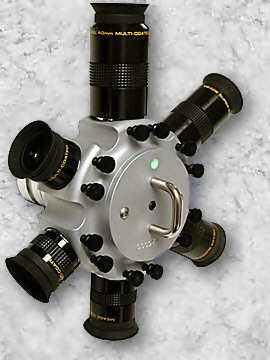
- NEW QUARTZ mirrors with individual Zygo interferometric analysis documentation
- 2" barrel-nose [full-aperture] input eliminates vignetting from low-power 1.25" eyepieces
- Exclusive built-in 2" filter slot makes changing filters for all 6 eyepieces instantaneous
- Exclusive dual rotation capablility allows instant eyepiece and mirror position changes
- 2" SCT Quad-Lock AHEX Revolver (optional) for "locked-in-place" Hex body rotation
- Double failsafe, angled self-locking Nylon thumb screws (10-32)
- Eyepiece thumb screws that tighten at an angle - like a lock washer but better
- Turret rotation locking thumb screw
- Convenient body rotation handle on rear of Hexagonal
- Ultra-quality ProtoStar QUARTZ first-surface mirror (see below for specs)
- Precision milled from solid 4.5" diameter 6061-T6 aluminum stock for single-piece accuracy
- All stainless steel/Nylon hardware
- Aircraft-grade 6060-T6 aluminum (NAS620 or AN960 aeronautics specs) or better
- Military specification 18-8 stainless steel (MS15795, MS27183 or ASTM A693) or better
- Positive spring-loaded ball bearing click stops at each eyepiece
- Luminous [glow-in-the-dark] indents for easy active eyepiece and filter locating in total darkness
- Dual purpose Quad-Lock system for secure Hex body rotation (also built into all VSI focusers)
- Filter size: 48 & 50mm (2") with a maximum cell thickness of 5/16" (0.3125")
- All SIX eyepiece output ports are 1.25" format
- Includes six 1.25" dust plugs and one 2" dust cap
- Maximum [eyepiece barrel] insert depth = 1.25"
- Dimensions: 4.5" diameter x 4.5" long (including 2" barrel-nose)
- Hex 1 weight = 25 oz. (approx. weight w/6 loaded eyepieces = 3 lbs)
Hexagonal 1 Turret General Information
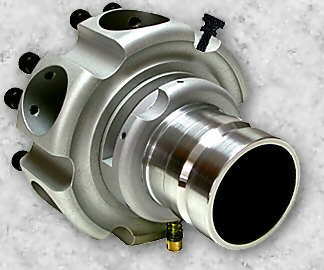
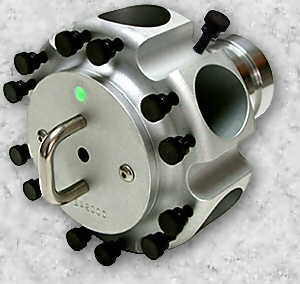
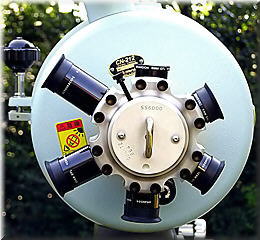 VSI's Hexagonal 1 offers a contoured European styling and DOUBLE Nylon (10-32) lateral locking thumb screws, incorporating our exclusive failsafe lateral locking system, on each eyepiece port. The Hex1 also features spring-loaded, ball bearing click stops at each of the six ports and rotary eyepiece cylinder lock-down thumb screw. Our exclusive, built-in 2" format filter slot offers instant filter changes for all 6 eyepieces. No removing eyepieces and fumbling with 1.25" filters for each individual eyepiece. You use one filter for all 6 eyepieces.
VSI's Hexagonal 1 offers a contoured European styling and DOUBLE Nylon (10-32) lateral locking thumb screws, incorporating our exclusive failsafe lateral locking system, on each eyepiece port. The Hex1 also features spring-loaded, ball bearing click stops at each of the six ports and rotary eyepiece cylinder lock-down thumb screw. Our exclusive, built-in 2" format filter slot offers instant filter changes for all 6 eyepieces. No removing eyepieces and fumbling with 1.25" filters for each individual eyepiece. You use one filter for all 6 eyepieces.
Note that all eyepieces should be [push-pull] parfocal positioned to eliminate refocusing when rotating from one eyepiece to another. If you have a matched set of parfocal eyepieces, all you do is pop them in and lock them down - you're done. If you have an unmatched set of different eyepieces, then simply parfocus each eyepiece by push-pulling until all eyepieces are parfocused. Note the green-white indented dot. It is filled with luminous paint that glows in the dark. This feature will easily indicate the active eyepiece position in total darkness.
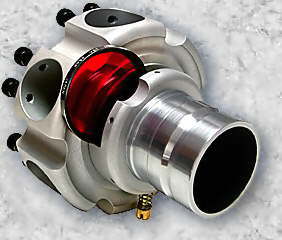 VSI's 2" to 1.25" x 6 Hexagonal 1 turret offers exclusive features and build-quality that other turrets don't. Our unique 2" format barrel-nose input with full 1.75" internal clear-aperture diagonal mirrors (ProtoStar QUARTZ 1.83" minor axis x 0.375" thickness), eliminates vignetting from fast scopes and/or low power 1.25" eyepieces (i.e. 40mm, 32mm, 26mm, 24mm, 20mm, etc.). The built-in 2" filter slot accepts 2" filters with a cell thickness up to 5/16" or 0.3125" (8mm). Just pop the filter in the spring-loaded slot and push the ejection button on the bottom and your filter is instantly ejected out into your hand (see picture at left). The Hex1 turret accommodates six 1.25" eyepieces (not included).
VSI's 2" to 1.25" x 6 Hexagonal 1 turret offers exclusive features and build-quality that other turrets don't. Our unique 2" format barrel-nose input with full 1.75" internal clear-aperture diagonal mirrors (ProtoStar QUARTZ 1.83" minor axis x 0.375" thickness), eliminates vignetting from fast scopes and/or low power 1.25" eyepieces (i.e. 40mm, 32mm, 26mm, 24mm, 20mm, etc.). The built-in 2" filter slot accepts 2" filters with a cell thickness up to 5/16" or 0.3125" (8mm). Just pop the filter in the spring-loaded slot and push the ejection button on the bottom and your filter is instantly ejected out into your hand (see picture at left). The Hex1 turret accommodates six 1.25" eyepieces (not included).
Functionality and simplicity of operation have always been VSI's trademark of quality. Our new Hexagonals are no exception. The entire Hex consists of only two major parts (the 2" barrel-nose tube structure and the rotating 6-eyepiece cylinder), with only one moving part (the rotating 6-eyepiece cylinder itself).
The Hex1 has a locking thumb screw that secures the rotation of the 6-eyepiece cylinder. No other turret eyepiece holder, that I know of, has this exclusive lock-down capability. Why would you want an eyepiece rotation lock? Same reason you want a focuser with a moving tube lock. And all individual eyepiece holders incorporate our exclusive, failsafe angled lock system. By placing the locking thumb screws at a 45 degree angle to the eyepiece's 1.25" barrel-nose, you apply lateral pressure as you tighten the thumb screw, locking it in place - like a lock washer. Each eyepiece on the Hex1 has dual angle, self-locking thumb screws for super secure failsafe operation.
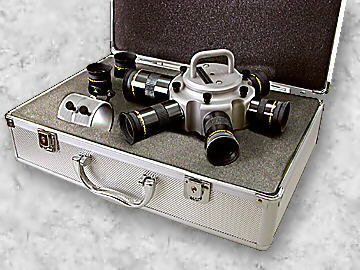 Load your Hex1 with eyepieces once, and you'll never have to fumble with eyepieces in the dark again. Find a custom eyepiece case, like the one pictured at right (not included), and you'll be instantly set up for mobile astronomy in the field. Just slide your fully loaded Hex1 into your scope's visual back and you're ready to observe. And you'll have the coolest looking, eye-catching scope at the star party!
Load your Hex1 with eyepieces once, and you'll never have to fumble with eyepieces in the dark again. Find a custom eyepiece case, like the one pictured at right (not included), and you'll be instantly set up for mobile astronomy in the field. Just slide your fully loaded Hex1 into your scope's visual back and you're ready to observe. And you'll have the coolest looking, eye-catching scope at the star party!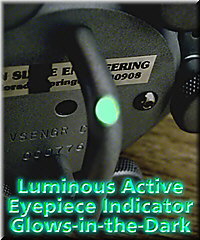 Why does the Hex1 have a long 2" barrel-nose that wastes profile? Profile is NOT wasted on the Hex. In conjunction with our optional AHEXSCT adapter, this added profile is ergonomically necessary so you don't hit your head on the back of your scope's visual back when trying to look through the eyepiece. If the Hex was fitted with a low-profile 2" threaded slip-ring (like our Sliders), the Hex1 would attach too close to your scope's visual back - ouch! If you have a secondary focuser docked to your scope's visual back, then you still have plenty of clearance for your head, and the Hex's 2" barrel-nose profile is consumed inside the focuser's moving tube - profile issue equalized. All 1.25" eyepiece turrets should have a 2" barrel-nose (unfortunately, none do), expecially when using 1.25" low-power, wide-field eyepieces because vignetting can be eliminated with a 2" format input. And Hexagonals also feature a huge internal 1.75" clear-aperture and oversize 1.83" minor-axis, first-surface QUARTZ mirror. Is this overkill?
Why does the Hex1 have a long 2" barrel-nose that wastes profile? Profile is NOT wasted on the Hex. In conjunction with our optional AHEXSCT adapter, this added profile is ergonomically necessary so you don't hit your head on the back of your scope's visual back when trying to look through the eyepiece. If the Hex was fitted with a low-profile 2" threaded slip-ring (like our Sliders), the Hex1 would attach too close to your scope's visual back - ouch! If you have a secondary focuser docked to your scope's visual back, then you still have plenty of clearance for your head, and the Hex's 2" barrel-nose profile is consumed inside the focuser's moving tube - profile issue equalized. All 1.25" eyepiece turrets should have a 2" barrel-nose (unfortunately, none do), expecially when using 1.25" low-power, wide-field eyepieces because vignetting can be eliminated with a 2" format input. And Hexagonals also feature a huge internal 1.75" clear-aperture and oversize 1.83" minor-axis, first-surface QUARTZ mirror. Is this overkill?
For your convenience, all VSI TOADLOADERS models, that incorporate the [dual purpose] QUAD-LOCK feature, allow their moving tubes to lock the Hex in place, while still providing full rotation of the Hex body (see AHEX SCT adapter below for more info). No other turret on the market has our exclusive dual rotation feature. Just turn the handle to the most comfortable active eyepiece position (no thumb screws to unscrew), then simply hold the handle in place and rotate the eyepiece cylinder to change magnifications. When speed and safety are paramount, this is the eyepiece turret you need. It's great for star parties, public viewing sessions, quick A/B object comparison using different eyepieces or filters. Slip a 2" filter in the Hexagonal's built-in filter slot and this exclusive convenience becomes a necessity.
NOTE: If you are using a VSI focuser with QUAD-LOCK, you don't need the SCT AHEX Revolver. See ADAPTERS link for more adapters.
VSI's Exclusive 2" Built-in Filter Slot
 Our New 2" format filter slot is now built into both Hex models - the 1.25" x 6 Hex1 (pictured at left) and the Giant 2" x 6 Hex2 (pictured far below). Each Hex comes with a fitted 2" OD ring (included) that simply pops into the filter slot, eliminating stray light from entering the housing when not in use. This stray light blocking ring is pictured (below left), inserted in the Hexagonal's filter slot. The finger notch, also pictured below left, allows easy grasping of the ring or filter after pushing the spring-loaded eject button on the bottom of the Hex1 housing (pictured below middle). The filter ring is held in place by a plate-type spring (pictured below right).
Our New 2" format filter slot is now built into both Hex models - the 1.25" x 6 Hex1 (pictured at left) and the Giant 2" x 6 Hex2 (pictured far below). Each Hex comes with a fitted 2" OD ring (included) that simply pops into the filter slot, eliminating stray light from entering the housing when not in use. This stray light blocking ring is pictured (below left), inserted in the Hexagonal's filter slot. The finger notch, also pictured below left, allows easy grasping of the ring or filter after pushing the spring-loaded eject button on the bottom of the Hex1 housing (pictured below middle). The filter ring is held in place by a plate-type spring (pictured below right).
This exclusive feature offers filter insertion and extraction in a split second, literally. No bulky filter wheels or separate slide mechanisms that gobble up your valuable profile and induce mechanical flexure into your imaging train. Our built-in filter slots consume only the profile thickness of the filter cell itself, which is typically less than 5/16" (8mm).
The filter slot was designed to accept the larger format 2" filters to eliminate vignetting caused by using 1.25" low-power, wide-field eyepieces (i.e. 40mm, 32mm, 24mm, etc.). This larger 2" format was selected because a 1.25" filter, at an extended distance from the eyepiece base, would cause more severe vignetting, compared to placement of the filter at the base of the eyepiece. This extended distance from the eyepiece would only allow the use of hi-power eyepieces. Therefore, this slot will only accept the larger, thinner 2" format filters with a cell thickness up to 5/16" or 0.3125" (8mm). Most 1.25" filters are actually thicker (0.45") and have an internal ring that reduces the available clear-aperture even further. See ADAPTERS link for other 2" filter slot adapters.
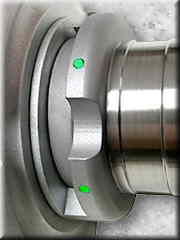
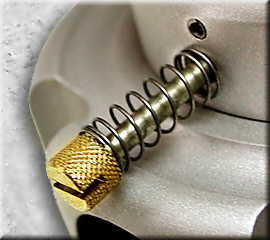
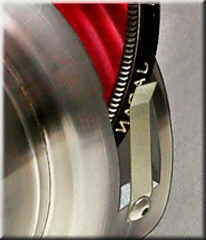
The Inside looks as Good as the Outside
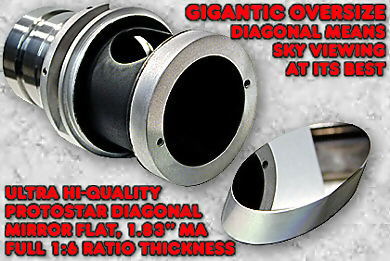
Hex1 turrets contain oversize optical-grade, first-surface, diagonal mirror flats from ProtoStar that have a huge 1.83" minor axis with a 0.375" thickness (1:6 ratio), and meet or exceed Milspec MIL-M-13508C. QUARTZ mirror with individual Zygo interferometric analysis documentation included with each Hexagonal. Wavefront flatness is typically better than 0.08 peak-to-valley measured at 633 nm light. Coatings provide the highest possible reflectivity across the entire visible spectrum with a thin pre-coat layer of chromium to promote good metal adhesion. Dielectric overcoat layers are applied using Electron Beam Deposition (EBD), followed by an ultra-hard Ion Assisted Deposition (true argon IAD) process.
Milling the Rotating 6-Eyepiece Cylinder
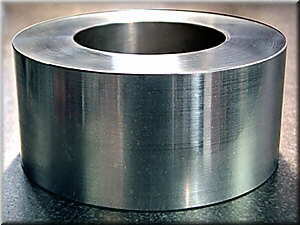
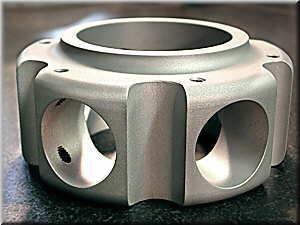
Like quality aluminum racing wheels, our Hexagonals are also machined from a solid billet of aircraft-grade 6061-T6 aluminum. After being turned on a lathe to a perfect cylinder (above left), the [4.5" O.D. by 1" wall thickness] blank is then milled on a digital mill (shown below) using a rotary indexing head with arc-second accuracy. This full-machining process is very time consuming and aircraft-grade aluminum is expensive, but the end result is far superior to cheap, thin, weak pot-metal castings or thin multi-part rotating housings, like the other rotary eyepiece holders on the market. The original billet blank (above left) weighs a little over 2 lbs (37.5 oz). After a copious amount of metal is removed (above right), the weight has been reduced to a mere 14 oz.
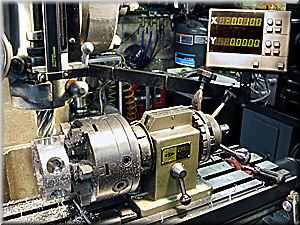
2" SCT Quad-Lock AHEX Revolver (optional)
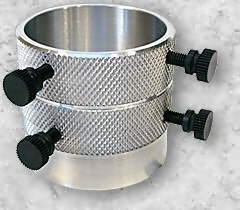
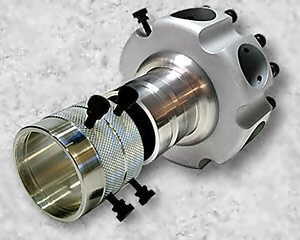
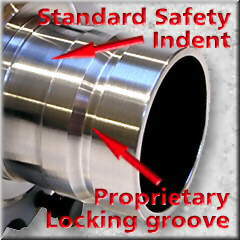 This VSI exclusive [2" format] SCT Quad-Lock captive revolver allows dual rotation of the Hex1. Screw it onto any 2"-24tpi SCT threaded visual back, slip the Hex1 into the Revolver and tighten the four [Quad-Lock] Nylon thumb screws. Then back them off a quarter turn [or so] until you can rotate the entire Hex1 easily. This unique dual-rotation feature allows the outer eyepiece housing to rotate normally (like any eyepiece turret) by holding the rear handle stationary to rotate to a different eyepiece and/or rotate the entire Hex1 to a more comfortable viewing position by allowing the rear handle to rotate with the Hex1, which rotates the entire Hex itself. It has industry-standard 2"-24tpi female SCT threads at the base of the adapter (pictured above right), double thumb screws at the top that lock into standard safety indents (see arrow at left), and our proprietary double thumb screws that are screwed into the proprietary locking groove in the barrel nose of our Hex1 (see arrow at left). It also doubles as a super-solid [Quad-Lock] SCT 2-inch barrel adapter when you need zero-flexure for astroimaging, etc.
This VSI exclusive [2" format] SCT Quad-Lock captive revolver allows dual rotation of the Hex1. Screw it onto any 2"-24tpi SCT threaded visual back, slip the Hex1 into the Revolver and tighten the four [Quad-Lock] Nylon thumb screws. Then back them off a quarter turn [or so] until you can rotate the entire Hex1 easily. This unique dual-rotation feature allows the outer eyepiece housing to rotate normally (like any eyepiece turret) by holding the rear handle stationary to rotate to a different eyepiece and/or rotate the entire Hex1 to a more comfortable viewing position by allowing the rear handle to rotate with the Hex1, which rotates the entire Hex itself. It has industry-standard 2"-24tpi female SCT threads at the base of the adapter (pictured above right), double thumb screws at the top that lock into standard safety indents (see arrow at left), and our proprietary double thumb screws that are screwed into the proprietary locking groove in the barrel nose of our Hex1 (see arrow at left). It also doubles as a super-solid [Quad-Lock] SCT 2-inch barrel adapter when you need zero-flexure for astroimaging, etc.
When the Hex1 is inserted in the Revolver, and the Quad-Lock thumb screws are properly engaged into the Hex grooves, you simply rotate the Hex body [active eyepiece] by using the convenient handle at the rear. Its like rotating a diagonal, but you don't have to loosen or tighten any thumb screws and the Hex is securely locked into the rotator. It's locked in place, but can still rotate by simply turning the rear handle. You then change your magnifications by holding the handle in place and rotating the outer cylinder from eyepiece to eyepiece (click - click - click).
For your added convenience, all VSI TOADLOADERS have Quad-Lock, and mimic the AHEX function (pictured above left). This exclusive body rotation bonus is part of the VSI focuser Quad-Lock feature that [also] locks your Hex into your VSI Toad, while still allowing instant Hex body rotation, just like the AHEXadapter. So, if you are using a VSI Toad with Quad-Lock, you don't need our AHEX SCT adapter. SeeADAPTERS link for additional adapters.
Note that this special AHEX adapter, or a VSI focuser, is not required to use our Hexagonals. Our 1.25" Hexagonal turrets (above) fit in any standard 2" format focuser, etc. This proprietary feature, utilizing theAHEX adapter and/or our VSI focuser's Quad-Lock feature, just makes it a little more secure and very convenient to operate, allowing the Hex housing to rotate freely without loosening any thumb screws.
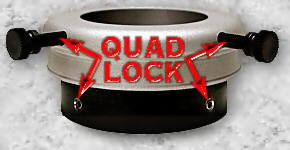
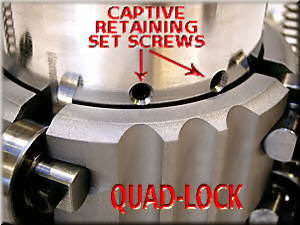

Black Forest Fire Destroyed VSI's Digital Machine Shop
UPDATE #2
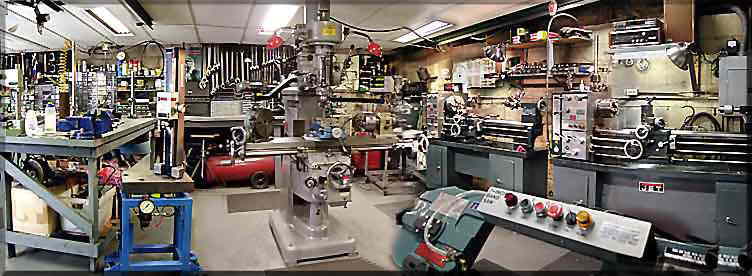
BEFORE (above) and AFTER (below)
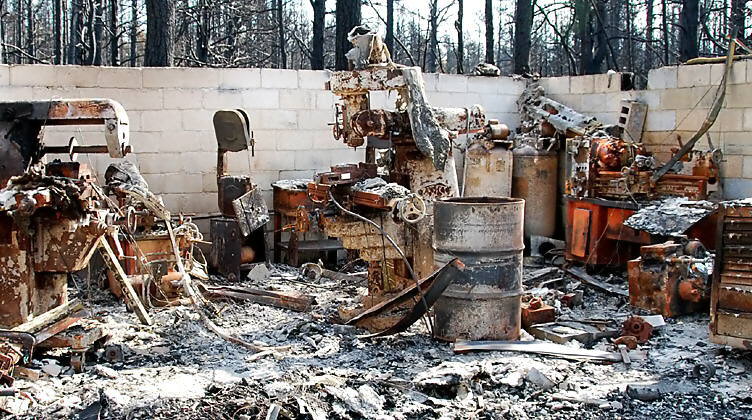
First came the fire, then the floods/ What next?
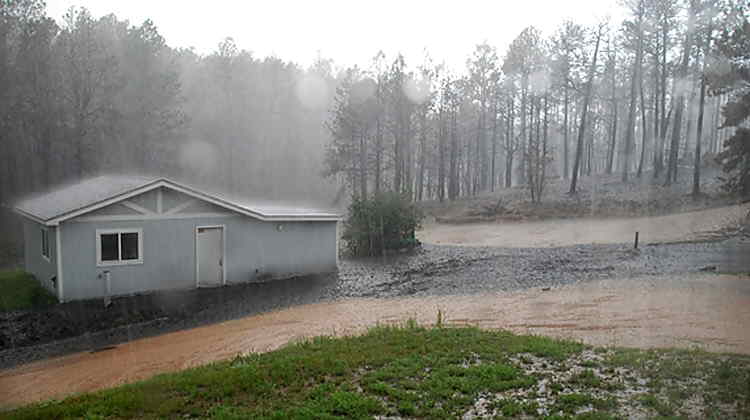
This is the 2nd update in the continuing story of the fiery demise of VSI. It's been 3 months since the fire. Progress is being made every day. After 5 flash floods of nasty black water (see picture above), we now have a trench diverting the water away from the old Black Forest Observatory (BFO) building so it will not be deluged with black water from future floods. The old VSI machine shop is gone (up the hill to the right of BFO). The excavator has removed all debris and left the concrete pad intact. However, I am abandoning the old shop sight.
I have decided to rebuild my shop on a personal level (appropriately) in the old BFO building (pictured above with it's newer pitch roof that was added after BFO was sold about 10 plus years ago). This structure has been many things in the past - observatory, office, shipping and receiving, product and personal storage, etc. Now it will be my new personal shop. Emphasize personal, not production.
New machine tools (lathe, mill, bandsaws, etc.) have already been installed and the restoration of some of the tooling from the fire has begun in the structure pictured above and will continue until next summer, or beyond if warranted. About half of the tooling (spacers, rotary tables, indexing heads, lathe chucks, etc.) is not recoverable because of the fire rust and seizing of integral parts. Some will be replaced, most will not.
Many of the stock assembled VSI products were sold shortly after the news of the fire was released. However, I have a few of the last of the VSI products available. These assembled products were stored in the BFO building. Note that over 50 VSI products that were not assembled, and existed only as parts, were stored at the machine shop and melted in the extremely hot fire.
As of this writing (Friday the 13th, 2013), I have almost all product port rings and adapters available, because I always kept quantities of these accessory parts in stock. You can order any of the port rings or adapters listed at VSI's website until quantities are exhausted. Payment by credit card is no longer available (check, MO, etc.). Of course, returns can not be accepted. If you own VSI major products that accept port rings or adapters, I would suggest thinking about your future applications now, rather than later.
Of the major VSI products available, I have one manual Zerotator. That's all folks! Call me if you are interested. These links are For Your Information Only. To reiterate, VSI is officially Out-of-Business. - PBVS
Rob Miller's TRI36M and accessories By Richard Keppler
https://www.astromart.com/reviews/article.asp?article_id=848
I'm back with part 2 of my review / description of Rob Miller's wonderful tripods and accessories. Part 1 concentrated on the TRI36L, the lightest version of this tripod family and how it operates. This commentary will concentrate a bit more on the accessories available for these superb tripods and will showcase a little bit about the medium duty version, the TRI36M.
First off, if you haven’t read part 1 of the review, I suggest you do so. Why? Well, because I am not going into any sort of detail of the operation of the tripod itself. All three versions, the L)ight, M)edium and H)eavy are basically identical with the exception of the size of the hardware they are built from and with. In other words, if you know how the TRI36L sets up, you know exactly how the TRI36H sets up. The operation is identical. The differences are in the physical size and weight of each mount, the options for mounting, and thereby the carrying capacities.
Here are a couple of pics of the TRI36M. One is just the tripod sitting alone and ready for use with an AP900 mount. The second shows it loaded up with the mount, extensions, plates, rings, scope, guidescope, cameras, and just enough wiring to give one a bit of a headache when tracing back something not quite connecting properly. Once it is set up and operating, it is a dream to use and the TRI36M tripod is the base which holds it all with aplomb.
As mentioned in the previous review, the TRI36L weighs under 10 pounds, a total lightweight, and yet is rigid and more than sufficient for a few hundred pounds of equipment. I wanted to have two rigs to use since there really isn’t a lot to do once the imaging scope is up and running. I decided on getting a TRI36M very quickly after receiving the TRI36L and seeing for myself how excellent it really was. I felt the heavier tripod would be better suited to my larger telescopes yet would still be very lightweight and most importantly, Rob wasn’t offering a mounting surface for the TRI36L which would accommodate my AP900! The TRI36M currently has several options available for mounting an AP900, AP1200, Bisque MX, or a Mach1GTO via an AP adapter. More options may be available by request. So the next question is how much more does the TRI36M weigh? Not much! It comes in at well under 14 pounds in the base state. Adding optional leveling feet or pier extensions will raise this by a pound or two, but it is still incredibly light yet incredibly strong and stable.
One option I knew I would require is a "pillar" or "pier" portion to get the long refractor assembly and camera up away from the tripod legs, otherwise I was going to severely limit the amount of sky I could "see". I ordered two of the four inch extensions with the thought of adding another one if these two did not give me the required leg clearance. They are shown in the next series of photos being added to the tripod.
The process is relatively simple in that the six stainless steel grub screws holding the rotating top plate are removed. The central pivot is removed via three small hex bolts, under which is a shoulder bolt holding the top plate down. Once this bolt is removed, the top plate lifts off. I threaded the shoulder bolt back in place and tightened it just enough so that it would not fall out inadvertently, and I would not lose it were I to remove the extensions for any reason. The AP pivot must be replaced in the top plate for the AP900 mount, and is re-attached using the original three small hex bolts. I suggest doing this as soon as possible in order to minimize the inadvertent misplacement of these small bolts. Once this is complete, set the extension in place and replace the original stainless grub screws with standard steel grub screws provided for this purpose, loosely threaded in to position.
Note the small curved cut-outs on the extension which are marked with a small index mark just above each. These grooves are where the grub screws are going to sit to hold and lock the extension, and the index marks make it easy to rotate the extension to the proper position to ensure the proper placement. Once the extension is in place you can drop the top plate into position or add up to two more extensions first. I have two so the next extension is attached in exactly the same manner to the top of the previous extension. Once the two extensions were in place, I placed the top plate back on the 'pier' so formed and re-inserted the stainless steel grub screws to hold it in place.
One modification readers will note is that I have replaced all six of the stainless grub screws attaching the rotating top plate with stainless thumbscrews. This allows me to easily release the top plate and rotate it to the position I want. This feature is designed into the tripod and would ordinarily be done via releasing of the grub screws with a proper sized Allen wrench. Since the top plate is not held in place by the central shoulder bolt any longer, the user should ensure that his telescope mount is very well balanced on top of the pier. While it is highly unlikely that it could pop loose due to the method the top plate fits down into and is held by the stainless setscrews, or, in my case, the thumbscrews, it could conceivably tilt and jam were the thumb or grub screws released sufficiently to allow it to do so.
One of the very best accessories, in my opinion, are the three leveling feet. A set of three of the regular version will set you back around $200 at this time. A set of three of the heavy duty version are around $270 if I recall properly. Initially I had two sets of the regular version, one on each of the tripods. I found them to be perfect on the light TRI36L tripod but they were a little more difficult to handle on the medium tripod once it was loaded down with well over 120 pounds of gear. Rob soon made a set of heavy duty leveling feet and I swapped them out without hesitation for use on the TRI36M. Here is a picture of both the TRI36L with the regular feet and the TRI36M with the heavy duty version. Although they look very similar, the heavy duty version features a thicker shaft with finer threading reducing the torque required to turn it, and larger knob size for easier gripping and increased torque. While they are not absolutely necessary, I cannot emphasize how much a set of leveling feet will improve the ease of use of the tripod and the resulting pleasure of ownership.
One of the other items Rob has designed for the tripod is a set of extension plates which clip on to the central tray forming the locking portion of the leg spreader assembly. There are three plates in a set and one piece of each just clips on the corresponding concave portion of the main tray. There is a curved slot on the extension which matches a curved ridge on the exterior boundary of the tray. The extension plate literally drops into position and is surprisingly difficult to dislodge accidentally, yet will lift straight out very easily.
A few of the pictures here show stainless shoulder bolts sticking out the side of the extensions at random places. Yes the positions appear to be random but I put the bolts there on purpose as places to hang or tie off cables, hand controllers, and what have you. They are simply 5/16 – 18 bolts threaded in to pre-threaded holes into the sides of the extensions up to the non-threaded portion of the bolt shaft and lightly tightened so that they do not loosen accidentally or vibrate out in transport.
Overall, I am extremely pleased with my two Rob Miller tripods. They are relatively inexpensive when one considers the quality of construction. They are extremely lightweight, yet superbly made, and incredible performers. Rob has mentioned several times that he will have some web pages up 'real soon now', and I expect this will happen "soon". For now, he has been placing sponsor ads on Astromart and is listed in the sponsor section. You can contact him at robmiller1950@comcast.net at the present time (Feb 2012).
There have been rumblings of a few other accessory pieces available or soon to be available as well. I will be sure to keep an eye out for anything interesting and useful to the way I use the tripods.
I'm back with part 2 of my review / description of Rob Miller's wonderful tripods and accessories. Part 1 concentrated on the TRI36L, the lightest version of this tripod family and how it operates. This commentary will concentrate a bit more on the accessories available for these superb tripods and will showcase a little bit about the medium duty version, the TRI36M.
First off, if you haven’t read part 1 of the review, I suggest you do so. Why? Well, because I am not going into any sort of detail of the operation of the tripod itself. All three versions, the L)ight, M)edium and H)eavy are basically identical with the exception of the size of the hardware they are built from and with. In other words, if you know how the TRI36L sets up, you know exactly how the TRI36H sets up. The operation is identical. The differences are in the physical size and weight of each mount, the options for mounting, and thereby the carrying capacities.
 |
| TRI36M with accesories. |
 |
| TRI36M loaded down. |
Here are a couple of pics of the TRI36M. One is just the tripod sitting alone and ready for use with an AP900 mount. The second shows it loaded up with the mount, extensions, plates, rings, scope, guidescope, cameras, and just enough wiring to give one a bit of a headache when tracing back something not quite connecting properly. Once it is set up and operating, it is a dream to use and the TRI36M tripod is the base which holds it all with aplomb.
As mentioned in the previous review, the TRI36L weighs under 10 pounds, a total lightweight, and yet is rigid and more than sufficient for a few hundred pounds of equipment. I wanted to have two rigs to use since there really isn’t a lot to do once the imaging scope is up and running. I decided on getting a TRI36M very quickly after receiving the TRI36L and seeing for myself how excellent it really was. I felt the heavier tripod would be better suited to my larger telescopes yet would still be very lightweight and most importantly, Rob wasn’t offering a mounting surface for the TRI36L which would accommodate my AP900! The TRI36M currently has several options available for mounting an AP900, AP1200, Bisque MX, or a Mach1GTO via an AP adapter. More options may be available by request. So the next question is how much more does the TRI36M weigh? Not much! It comes in at well under 14 pounds in the base state. Adding optional leveling feet or pier extensions will raise this by a pound or two, but it is still incredibly light yet incredibly strong and stable.
 |
| AP900 Plate and Two Extensions! |
One option I knew I would require is a "pillar" or "pier" portion to get the long refractor assembly and camera up away from the tripod legs, otherwise I was going to severely limit the amount of sky I could "see". I ordered two of the four inch extensions with the thought of adding another one if these two did not give me the required leg clearance. They are shown in the next series of photos being added to the tripod.
 |
| Basic TRI36M with Rotatable Top Plate |
 |
| Extension Alignment |
 |
| One Extension in Place with Top Plate |
Note the small curved cut-outs on the extension which are marked with a small index mark just above each. These grooves are where the grub screws are going to sit to hold and lock the extension, and the index marks make it easy to rotate the extension to the proper position to ensure the proper placement. Once the extension is in place you can drop the top plate into position or add up to two more extensions first. I have two so the next extension is attached in exactly the same manner to the top of the previous extension. Once the two extensions were in place, I placed the top plate back on the 'pier' so formed and re-inserted the stainless steel grub screws to hold it in place.
 |
| Close-Up of Capture Flange on Rotatable Top Plate |
 |
| Another Flange Close-Up |
 |
| Regular Leveling Feet (Left) Versus Heavy Leveling Feet (Right) |
 |
| Another View of the Leveling Feet |
One of the very best accessories, in my opinion, are the three leveling feet. A set of three of the regular version will set you back around $200 at this time. A set of three of the heavy duty version are around $270 if I recall properly. Initially I had two sets of the regular version, one on each of the tripods. I found them to be perfect on the light TRI36L tripod but they were a little more difficult to handle on the medium tripod once it was loaded down with well over 120 pounds of gear. Rob soon made a set of heavy duty leveling feet and I swapped them out without hesitation for use on the TRI36M. Here is a picture of both the TRI36L with the regular feet and the TRI36M with the heavy duty version. Although they look very similar, the heavy duty version features a thicker shaft with finer threading reducing the torque required to turn it, and larger knob size for easier gripping and increased torque. While they are not absolutely necessary, I cannot emphasize how much a set of leveling feet will improve the ease of use of the tripod and the resulting pleasure of ownership.
 |
| Extension Accessory Trays |
 |
| and a view of the Extension Accessory Tray on the TRI36M |
 |
| The AP Mach1GTO/AP600/AP400 adapter on the TRI36M AP900 Plate |
A few of the pictures here show stainless shoulder bolts sticking out the side of the extensions at random places. Yes the positions appear to be random but I put the bolts there on purpose as places to hang or tie off cables, hand controllers, and what have you. They are simply 5/16 – 18 bolts threaded in to pre-threaded holes into the sides of the extensions up to the non-threaded portion of the bolt shaft and lightly tightened so that they do not loosen accidentally or vibrate out in transport.
Overall, I am extremely pleased with my two Rob Miller tripods. They are relatively inexpensive when one considers the quality of construction. They are extremely lightweight, yet superbly made, and incredible performers. Rob has mentioned several times that he will have some web pages up 'real soon now', and I expect this will happen "soon". For now, he has been placing sponsor ads on Astromart and is listed in the sponsor section. You can contact him at robmiller1950@comcast.net at the present time (Feb 2012).
There have been rumblings of a few other accessory pieces available or soon to be available as well. I will be sure to keep an eye out for anything interesting and useful to the way I use the tripods.
Subscribe to:
Posts (Atom)
